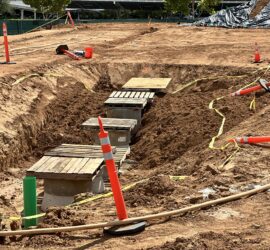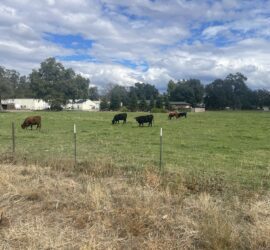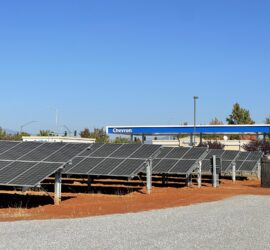Phase 1 Environmental Site Assessment (Phase I ESA)
A Phase 1 Environmental Site Assessment is a scientific report following ASTM Standards that evaluate the environmental risks and liabilities of a property. It is often referred to as a Phase I ESA or Phase I Environmental Assessment, and can be part of the real estate due diligence process. To start, a Phase 1 ESA studies the historical and current land uses of a property. Additionally, it documents the likelihood of contamination. Modernly, it considers outside and nearby contamination sources. For instance, an apartment complex today may have been a gas station 90 years ago. The property may still have underground storage tanks and contamination. Updated April 11, 2024.
Phase I ESA Federal Standards & Guidelines
There are federal guidelines and standards to regulate the quality of Phase 1 Environmental Site Assessment reports. A proper Phase I Environmental Site Assessment can assist with protecting innocent landowners from unforeseeable environmental concerns. For instance, when a Phase 1 ESA report meets all guidelines, it can qualify the landowner for legal liability protection and financial assistance with the cleanup process. For this purpose, the All Appropriate Inquiry (AAI) rule is in place.
Although not all users of a Phase 1 Environmental Assessment may qualify. Aside from the ESA report itself, the users of the reports and owner of a property must also meet specific criteria. Additionally, government agency funding must be available at the time.
American Society for Testing & Materials
Additionally, the American Society for Testing and Materials (ASTM) administers standards for a Phase 1 Environmental Site Assessment. Similarly, these standards generally comply with the CERCLA’s Innocent Land Owner (ILO) defense policies. Purchasers looking to qualify for CERCLA liability protection require a comprehensive Phase I Environmental Assessment report that also complies with ASTM Standards.
The ASTM Standards for Phase 1 ESA reports change periodically. To illustrate, the current standard practice guidance was released during the year 2013. Thus it has document number ASTM E1527-13. However, the prior Phase I ESA standard practice document was published in the year 2005, thus being document number E1527-05.
As times change, so do our nation’s environmental laws and regulatory agency standards. These changes factor into the scope of work amendments of the ASTM Phase I Environmental Site Assessment standards. Moreover, discoveries in health science, new technologies, and current events also play a role in the making of ASTM standards. For example, scientific research and developments in the area of toxic vapor intrusion and migration during the mid-2000s prompted an amendment to the Phase 1 Environmental Site Assessment process. As a result, the E1527-13 standard requires a vapor encroachment assessment as well. Similarly, with the modern-day advancements of drone technology and thermal-detection cameras, geologists anticipate more scope updates for a Phase 1 Environmental Assessment in the near future.
User-Specific Standards
In some cases, a Phase 1 ESA report comprises additional components per the user’s request. These are “user-specific standards” that are above and beyond the ASTM standard. They generally aim to qualify Phase I Environmental Assessment reports with an institution’s internal guidelines. For example, the Department of Housing and Urban Development (HUD) and the Small Business Administration each administer internal standards for Phase 1 Environmental Assessment reports. In fact, these additional requirements build on the legal and financial aspects of ASTM and federal standards. Consequently, the Phase I ESA process becomes more comprehensive.
A Phase 1 Environmental Site Assessment report compliant with HUD standards qualifies under the “Multifamily Accelerate Process.” Similarly, Phase I Environmental Site Assessment reports compliant with SBA standards qualify for SBA-504 or 7(a) loans against commercial and industrial real estate.
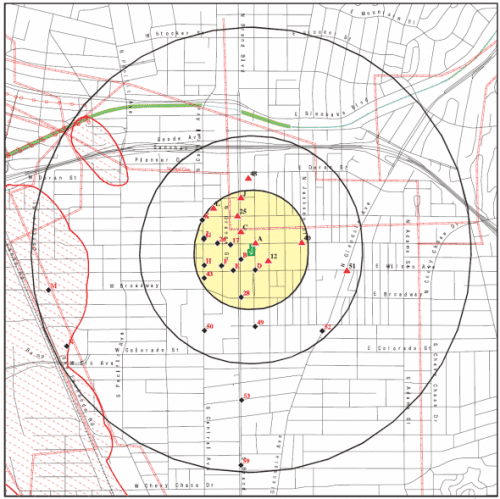
The Phase 1 ESA at Pre-Purchase
A Phase 1 Environmental Site Assessment is a common requirement at the pre-purchase and loan qualification stage of property acquisition. This real estate due diligence report provides buyers and sellers with an assessment concerning any potential environmental conditions that may exist at a site. The ultimate purpose of a Phase I ESA is for the user to document the environmental risk of a property, prior to a transaction and development.
Multiple Parties
In most cases, multiple parties fall under the “report-user” category and require legal reliance. Sometimes, a public health concern may arise from the Phase I Environmental Assessment process, yielding the requirement for local health departments to legally rely on the report. The environmental professional’s liability and efforts multiply in parallel with the number of private clients, and the presence of regulatory agencies. Thus, it is vital to clear up the recipient parties at the start of the project, for accurate and proper pricing. And the obligations to report or withhold the results of a Phase 1 ESA to outside parties or agencies can be complex. In such cases, Geo Forward always recommends a professional consultation with a geologist, as well as legal counsel.
What is the Phase I Environmental Assessment Scope of Work?
The Phase I Environmental Site Assessment process extensively taps into multiple sources of information and comprises strategic environmental compliance audits within each pillar. The standard practice is a master guide to strategically identify any environmental compliance violation at a site, whether historical or concurrent. The ASTM standards require each Phase 1 Environmental Site Assessment to have proper certification by registered environmental professionals, such as geologists and engineers. To illustrate the components of a typical Phase 1 ESA, the following items are part of the assessment.
- Job Site Visit or Site Reconnaissance.
- Environmental Compliance Inspections.
- Historical Property Information Compilation.
- In-Person Regulatory Agency File Reviews.
- Database Reports and Government Record Audits.
- Study and Analysis of the Site Geology and Hydrogeology.
- Vapor Intrusion Risk Modeling.
- Researching Environmental Liens and Activity Use Limitations.
- Conclusions and Recommendations by Professional Geologists.
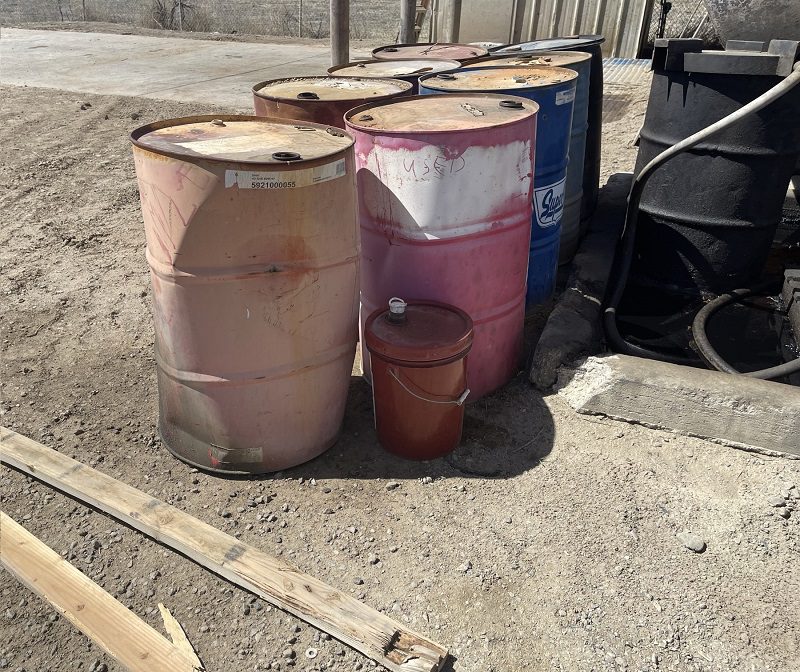
What are the Main Steps within a Phase 1 Environmental Assessment?
Each Phase 1 ESA report varies to some extent. A Phase I ESA in some jurisdictions can have many different components than in other areas. Ultimately, the sources of information and the quantity of supporting documents depend on what is available. All ESA reports require a plethora of information. Nonetheless, above the variable components, there are primary components that are universal to the modern ASTM standard. The following sections are just a few of the main components of a Phase I Environmental Assessment.
Step 1 – Comprehensive Review of an ASTM REC Review Government Database Review Report
One of the many components of a Phase 1 Environmental Site Assessment is a regulatory agency database report. This is a lengthy document that provides a compilation of digitally available regulatory files at the subject property, as well as it’s surrounding areas. Government database reports can comprise city, county, state, and federal agency records. However, they are also known to have data gaps. Data gaps occur because many environmental conditions remain undocumented, or had occurred during a time of lax policy. As a result, a property can still have contamination issues from a past undocumented event and remain unlisted on any government agency databases.
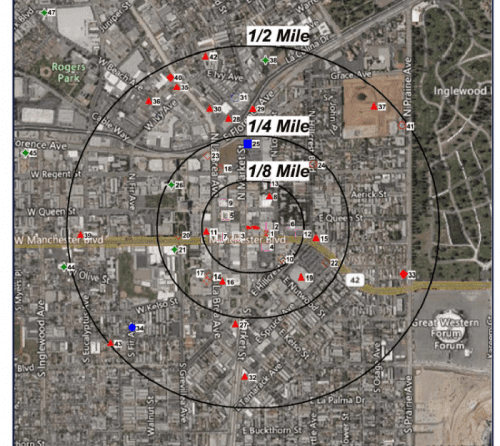
Step 2 – Thorough Review of Historical Aerial Images
Each Phase I Environmental Assessment also comprises a careful review of historical aerial images. Some images date back to the early 1900s, and can be the only source of documentation for historically recognized environmental conditions on a site. For instance, this component is handy for identifying above-ground crude oil tanks, gasoline service stations, mining operations, and other environmentally impacting operations.
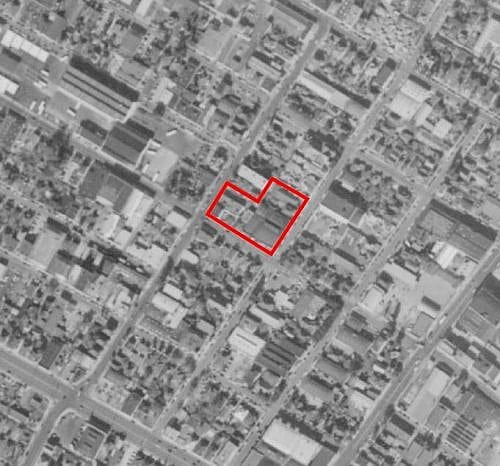
Step 3 – Detailed Study of Historical Fire Insurance Maps
One helpful component of a Phase 1 ESA is the fire insurance map compilation. Fire insurance maps are historical documents formerly applicable to gauge the combustibility of buildings within specific blocks. These maps are mostly available in dense areas and provide valuable information on the historical land uses of a property. Some fire insurance maps date back to the early 1900s.
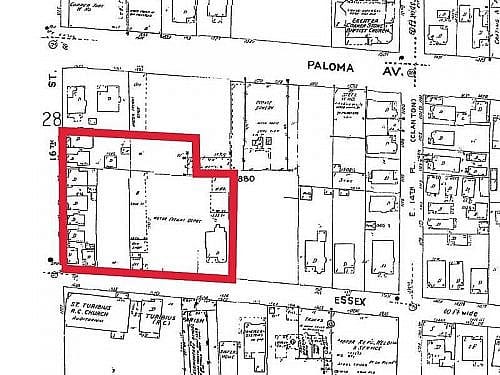
Step 4 – Reviewing Historical Topographic Maps
Phase I ESA reports also comprise a large compilation of historical topographic maps. These maps can date back to the late 1800s. Historical topo maps have mostly been the product of the national geological survey. However, in some cases, private mining and crude oil production companies have been commissioned to prepare the maps as well. The main utilization was for the documentation of terrain, as well as land development, mining, and crude oil pumping. These topo maps have also evolved over time with the use of new technology and information. Today, Phase 1 Environmental Site Assessment reports providing the opportunity to review the history of a site. Common observations of environmental conditions relate to potential oil well drilling and mining operations on-site. Additionally, above-ground tanks, bodies of water, railroad tracks, and roads are identifiable.
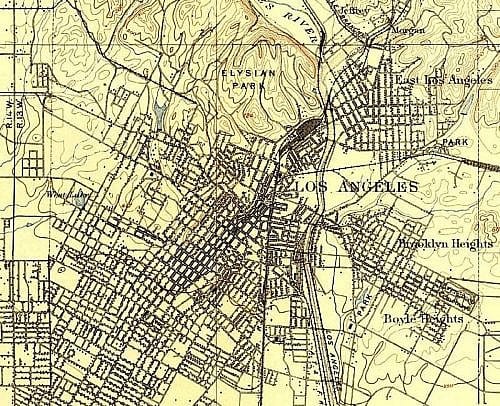
Step 5 – Checking City Directories for Critical Past Land Uses
Historical city directories are usually available within dense regions. These documents are helpful to the Phase I Environmental Assessment process because they allow environmental professionals to review the names and dates of businesses on-site. For instance, during a Phase 1 ESA, one may observe the listing “Max’s Dry Cleaning Shop” on-site during the years 198 through 1952. As a result, there is a reasonable presumption of dry cleaning soil contamination, thus resulting in a recommendation for a Phase 2 Environmental Site Assessment after the Phase I ESA. In most cases, city directory records date back to the 1800s. And most records of historical city directories are now under private ownership. The records are not always comprehensive and sometimes contain data gaps. Thus, much like any other component of a Phase 1 Environmental Assessment, they mustn’t be solely relied on.

No Further Action in Phase 1 Environmental Site Assessment Reports
Upon the completion of a Phase 1 Environmental Site Assessment, environmental professionals are required to evaluate the presence of any Recognized Environmental Condition (REC) that could lead to subsurface contamination. Additionally, the ASTM standards require the evaluation of potential Controlled Recognized Environmental Conditions (CRECs) and Historical Recognized Environmental Conditions (HRECs). If no such conditions come to light during a Phase 1 ESA, the conclusions generally lead to a “No Further Action” recommendation.
Phase 2 ESA Recommendations?
Upon recognizing environmental concerns during a Phase I ESA, recommendations for Phase 2 ESA subsurface testing may be necessary, per the ASTM standards. This continuation of the assessment is referred to as a Phase 2 Environmental Site Assessment, or Phase 2 Subsurface Investigation. The Phase 2 ESA scope of work is a function of the Recognized Environmental Conditions observed at the Subject Site. As a result, the Phase 2 ESA directly investigates whether those conditions are causing subsurface contamination, or not.
What Happens During a Phase 2 ESA?
A Phase 2 ESA is the in-situ subsurface investigation that is necessary by the findings of a Phase 1 Environmental Site Assessment. To illustrate, a Phase 2 ESA typically includes soil, soil gas, and groundwater testing, as well as laboratory analysis. Furthermore, the subsurface investigation can also include geophysical surveys to locate underground storage tanks (USTs) and pipelines. The results of the investigation compare directly against environmental screening levels set by government agencies. Similarly, the use of vapor intrusion investigation tools assists in determining whether occupants of a property are facing health risks, or not.
Other Possible Recommendations in a Phase 1 Environmental Site Assessment
Besides recommending a Phase 2 ESA, there are various environmental conditions that can lead to other types of remedial action and research recommendations. For instance, some Environmental Issues, CRECs, HRECs, and De Minimis Conditions result in the recommendation for additional agency research, geophysical surveys, drainage pipe examinations, vapor barrier installation, and source removal excavation.
Methane Gas Hazards
For example, although methane soil gas is an apparent danger for building occupants, there doesn’t appear to be an ASTM Phase 1 Environmental Assessment standard for it at this time. Most environmental professionals today categorize the presence of methane soil gas as an environmental issue. And recommendations typically defer to following local building department standards for methane soil gas testing and methane mitigation. In most cases, properties within a high methane gas zone or landfill area are likely to include recommendations for methane testing.
Underground Storage Tank Removal
If subsurface anomalies, such as underground storage tanks (USTs), leaking septic systems, or automobile lift systems exist, there may also be a recommendation for removal under the guidance of a soil management plan. For instance, underground storage tank excavation and hydraulic lift removal processes are necessary to ensure the lack of further contamination at a site. The longer leaking USTs and hydraulic lift hoists remain underground, the higher the risk for subsurface contamination is. Common contaminants of concern are volatile organic compounds (VOCs), polychlorinated biphenyls (PCBs), and petroleum hydrocarbons (TPH).
Recommendations for Indoor Air Quality Testing
Another potential recommendation of a Phase 1 ESA is Indoor Air Quality Testing. This process entails sampling indoor ambient air and screening for toxins. Common contaminants of concern are VOCs and gasoline range petroleum hydrocarbons (TPH). The objective is to determine the level of human health risk on-site, and accordingly prepare a mitigation plan and remedial action plan. However, a Phase 2 Subsurface Investigation and other drilling events are likely to occur simultaneously. This is to determine the lateral and vertical extent of the contamination before remediation.
Limited ESAs
In some cases, a Phase I Environmental Site Assessment report isn’t necessary to begin with. Alternatively, some lending institutions, such as the SBA, can initiate limited due diligence in the form of basic investigations. A limited environmental site assessment (such as a desktop environmental report or a transaction screen assessment) can serve as a preliminary tool to evaluate risk. Basing on the findings of these reports, there may or may not be a recommendation to follow through with a Phase 1 Environmental Assessment.
Suspicious Low-Cost Phase 1 ESAs
A low-cost Phase 1 Environmental Site Assessment is typically below the required standard. Usually, a low-cost Phase 1 ESA contains major errors and omissions. Errors on a critical assessment like this can result in expensive legal and regulatory agency fees. Moreover, there may be a requirement to clean up any contamination that is unforeseeable by the faulty Phase 1 Investigation ESA. Consumers should be aware of fair industry pricing of Phase I Environmental Site Assessment reports.
Case Example (The Year 2018, Los Angeles, CA): Company A is commissioned to conduct an environmental review on a property. Company B prepared a low-cost Phase I Environmental Assessment report on the same property two years before. During the review, Company A found significant errors and omissions. The low-cost report by Company B missed that there had been a gasoline station and underground storage tanks on the property for over a decade. Consequently, the low-cost Phase 1 Environmental Assessment report by Company B was disqualified under the Innocent Landowner Liability Protection Policy. The owner of the property is faced with high legal costs and cleanup responsibilities.
Environmental Questionnaire
Initially, in the due diligence period, lenders may require an environmental questionnaire. This typically applies to sales transactions or financing of a commercial property, prior to ordering a Phase 1 Environmental Assessment. The information within an environmental questionnaire is valuable to the Phase 1 Environmental Site Assessment process. In fact, when available, the questionnaire becomes part of the report and qualifies as considerable data for conclusions and recommendations. Technically, it falls under the “interviews” category of the assessment.
The form intends to provide facts about the property, under a legal certification of good faith. Under this presumption, a basic level of environmental risk can be evaluated and applied as a tool to enhance the accuracy of the Phase I Environmental Site Assessment report. However, a Phase 1 Environmental Site Assessment report does not solely rely on this information.
User Data Request Form
In some cases, a User Data Request Form will be required with a Phase 1 Environmental Site Assessment. The User Data Request Form inquires about the report user’s knowledge of environmental cleanup liens, if any. This form assists in satisfying the Brownfields Act for Innocent Landowner Liability Protection. Consequently, the parameters of the form also meet the “All Appropriate Inquiry” rule for a Phase I ESA. Additionally, the form inquires about any activity or land use limitations, the purchase price to fair market value, and other special information.
Reliance Letters
A Phase 1 Environmental Assessment reliance letter is a legal document that allows professional geologists to authorize other parties to use and rely on the report. These letters typically apply to Lenders and the SBA, and serve as an extension of liability. Thus, an additional cost usually applies. The Phase I ESA reliance letter is not an update or modification to the original Phase 1 Environmental Site Assessment report. As a result, a reliance letter implies no warranty that the condition of the property is the same as it was on the date of the Phase 1 ESA. A Phase 1 Environmental Site Assessment reliance letter can cost approximately $250 to $600.
How Long Does a Phase I Environmental Assessment Take?
A Phase I Environmental Site Assessment typically takes about 12 to 14 business days to complete. This is the standard turnaround timeframe and strongly relies on the response rates of local government agencies for records review purposes. Rush turnaround options are available for Phase 1 ESA reports, although the quality of the overall report is likely to be lower. To illustrate, local agencies holding underground storage tank (UST) removal records typically release files within a 10 to 12-business-day timeframe. So if a rush Phase 1 ESA is due in 5 business days, it will be missing the important documentation about whether a proper UST abandonment has taken place on-site, or not. Without these files, the Phase 1 Environmental Report will have a data gap, resulting in less reliable concussions and recommendations.
What is the Difference Between a Phase I and Phase II Environmental Site Assessment?
The difference between a Phase I and Phase II Environmental Site Assessment is large. A Phase 1 ESA is the first step of identifying potential environmental concerns, from a visual and non-visual standpoint. Any outliers or potentials for concern are accordingly reported. There is no direct sampling or testing of samples, within the Phase 1 ESA process. On the other hand, a Phase II Environmental Site Assessment uses geological drilling and sampling equipment to directly sample and test subsurface materials for contamination. The Phase 2 ESA scope of work builds off of the Phase I ESA findings, conclusions, and recommendations.
Professional Consultation
Geo Forward is a leading provider of Phase 1 Environmental Site Assessment reports for nationwide lenders, developers, and institutions. Reporting formats are variable and comprise executive summaries for fast and easy results. Standard and rush turnaround times are available. However, for better results, environmental professionals recommend a standard turnaround time. For more information about Phase I Environmental Site Assessment reports, call (888) 930-6604 to speak with a professional geologist. There is also the option to set up a consultation via the Geo Forward Pre-Consultation Questionnaire. The process is mobile-friendly, fast, and easy. Project information is NOT shared or sold.
Information Sources
All Appropriate Inquiries §312.20 – United States Government Publishing Office
American Society of Testing and Materials – E1527 Phase I Environmental Site Assessment Standards
California Department of Toxic Substance Control (DTSC) – Vapor Intrusion Guidance
Cornell University Law School and Legal Information Institute – CERCLA Laws
United States Environmental Protection Agency (EPA) Superfund Website

